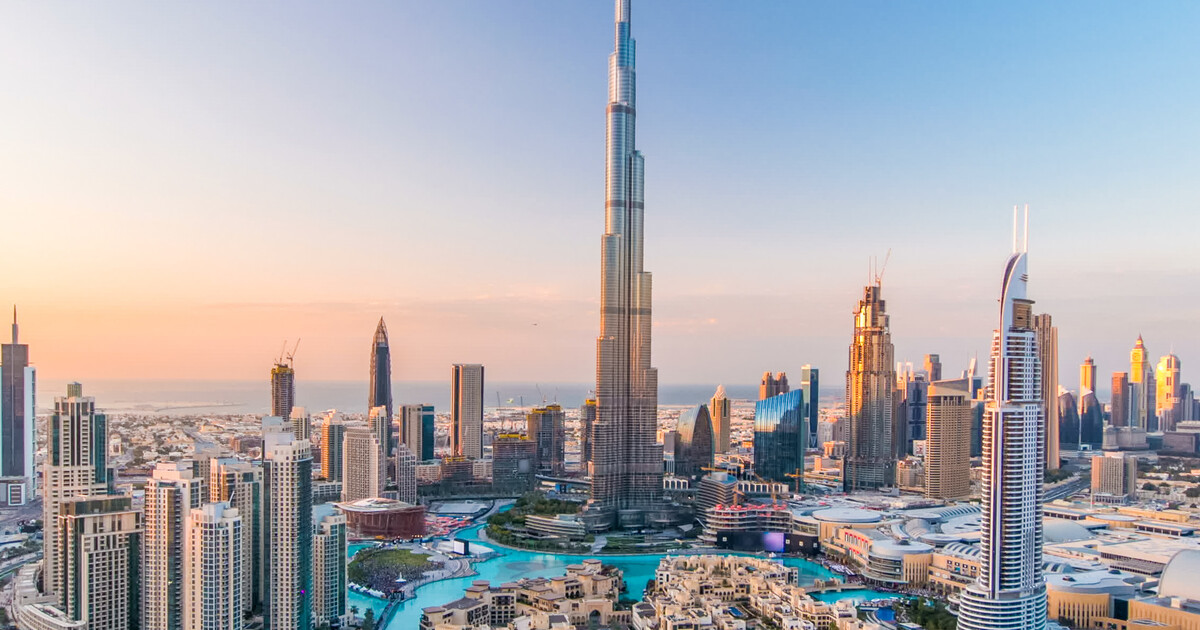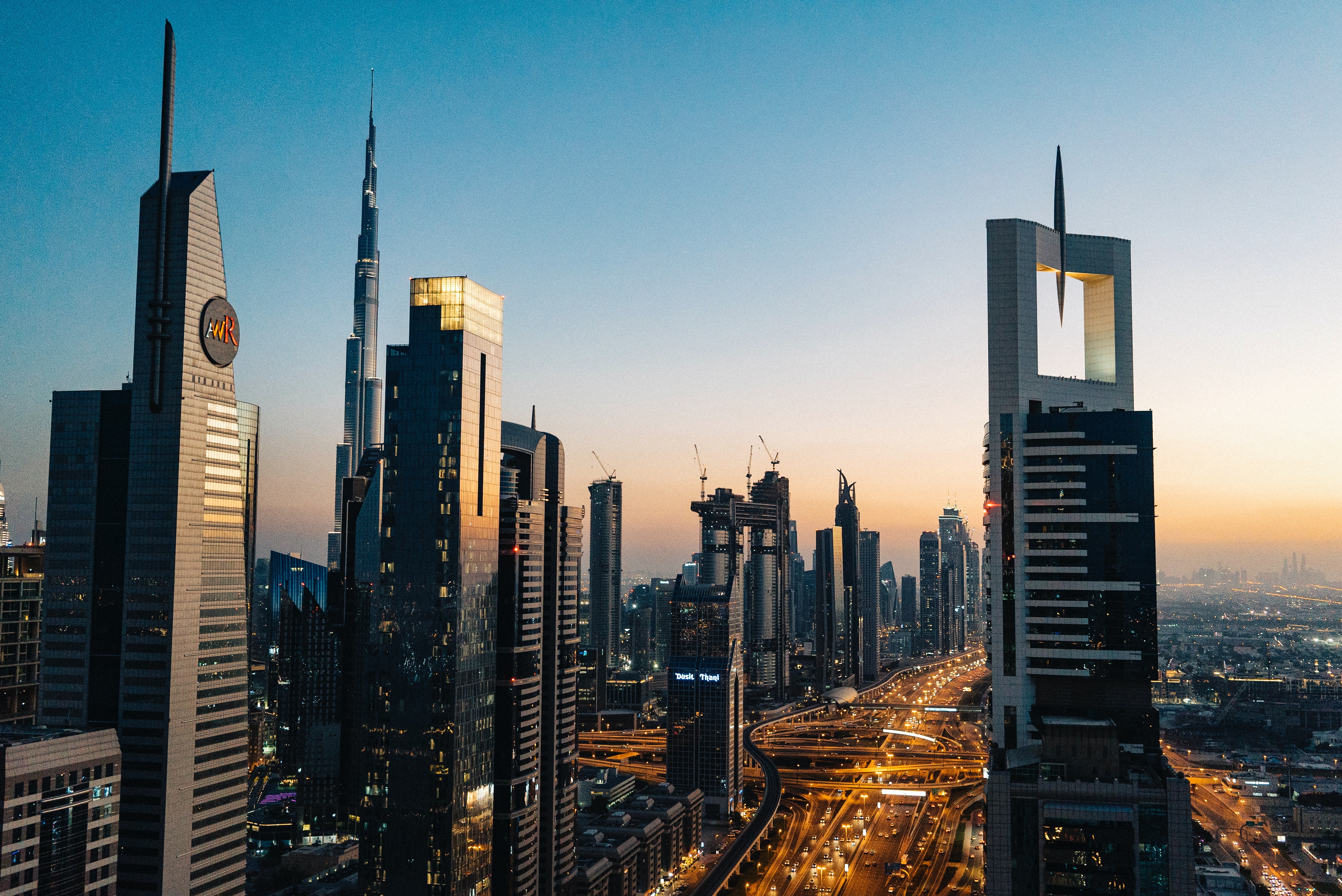
QUICK DUBAI TOUR !
DUBAI
The story of the emirate of Dubai revolves around that of Dubai City. The emirate was established by the Al Maktum ruling family around 1833 when the family's clan, the Al Bu Falasa, broke away from the Bani Yas tribal confederation that dominated the region of Abu Dhabi. In its early years Dubai was a small fishing village on the best natural harbor (called Dubai Creek) in the region. Under the Al Maktum rulers it became an important pearling port, and by the early years of the twentieth century it was second only to Kuwait among the commercial ports on the Arab side of the Persian Gulf.
* PLACES IN DUBAI WHICH ATTRACTS PEOPLE FROM AROUND THE WORLD :
1.Burj Khalifa
Burj Khalifa
Dubai's landmark building is the Burj Khalifa, which at 829.8 meters is the tallest building in the world and the most famous of the city's points of interest. For most visitors, a trip to the observation deck on the 124th floor here is a must-do while in the city. The views across the city skyline from this bird's-eye perspective are simply staggering. The slick observation deck experience includes a multimedia presentation on both Dubai and the building of the Burj Khalifa (completed in 2010) before a high-speed elevator whizzes you up to the observation deck for those 360-degree views out across the skyscrapers to the desert on one side and the ocean on the other.
Nighttime visits are particularly popular with photographers due to Dubai's famous city-lights panoramas. Buy your Burj Khalifa "At the Top" Entrance Ticket in advance to avoid long line-ups, especially if you are planning to visit on a weekend.
Back on the ground, wrapping around the Burj Khalifa, are the building's beautifully designed gardens, with winding walkways. There are plenty of water features including the Dubai Fountain, the world's tallest performing fountain, modeled on the famous Fountains of Bellagio in Las Vegas.
2. Dubai Mall
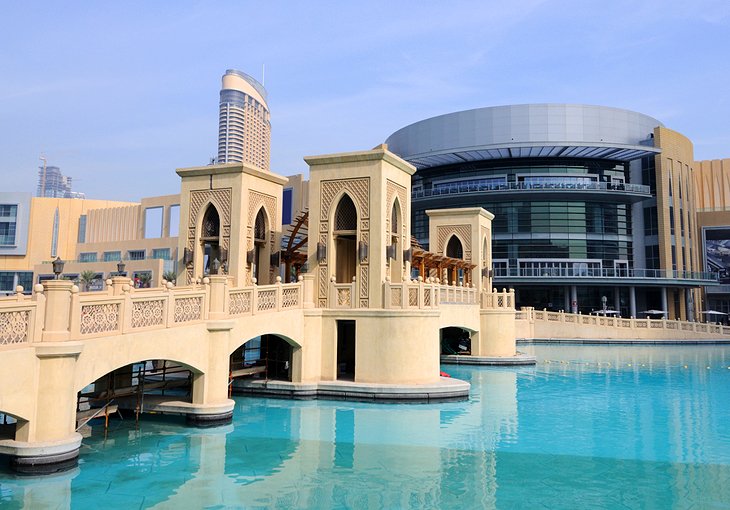
Dubai Mall
Dubai Mall is the city's premier mall and provides entry to the Burj Khalifa, as well as the Dubai Aquarium. There is also an ice-skating rink, gaming zone, and cinema complex if you're looking for more entertainment options. The shopping and eating is endless, and there are nearly always special events such as live music and fashion shows within the mall. The most famous of these are the annual Dubai Shopping Festival in January and February and the Dubai Summer Surprises Festival in July and August.
Location: Doha Road, just off Sheikh Zayed Road
3. Dubai Museum
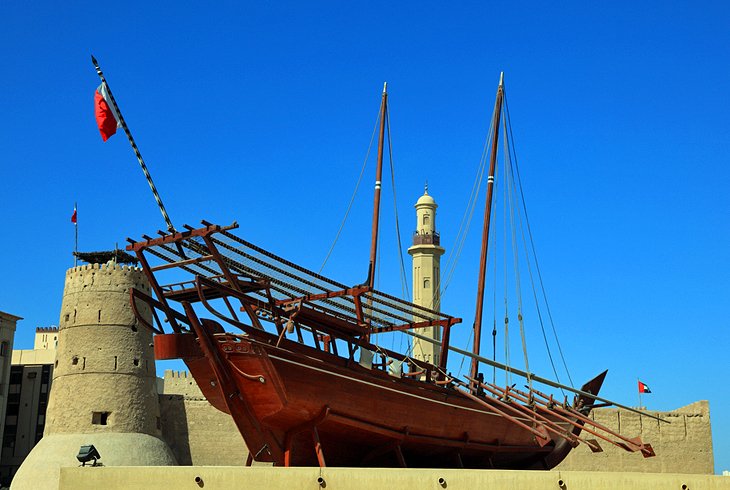
Dubai Museum
Dubai's excellent museum is housed in the Al-Fahidi Fort, built in 1787 to defend Dubai Creek. The fort's walls are built out of traditional coral-blocks and held together with lime. The upper floor is supported by wooden poles, and the ceiling is constructed from palm fronds, mud, and plaster.
In its history, the fort has served as a residence for the ruling family, a seat of government, garrison, and prison. Restored in 1971 (and again extensively in 1995), it is now the city's premier museum. The entrance has a fascinating exhibition of old maps of the Emirates and Dubai, showing the mammoth expansion that hit the region after the oil boom.
The courtyard is home to several traditional boats and a palm-leaf house with an Emirati wind-tower. The right-hand hall features weaponry, and the left-hand hall showcases Emirati musical instruments. Below the ground floor are display halls with exhibits and dioramas covering various aspects of traditional Emirati life (including pearl fishing and Bedouin desert life), as well as artifacts from the 3,000- to 4,000-year-old graves at Al Qusais archaeological site.
Address: Al-Fahidi Street, Al-Fahidi
4. Bastakia (Old Dubai)
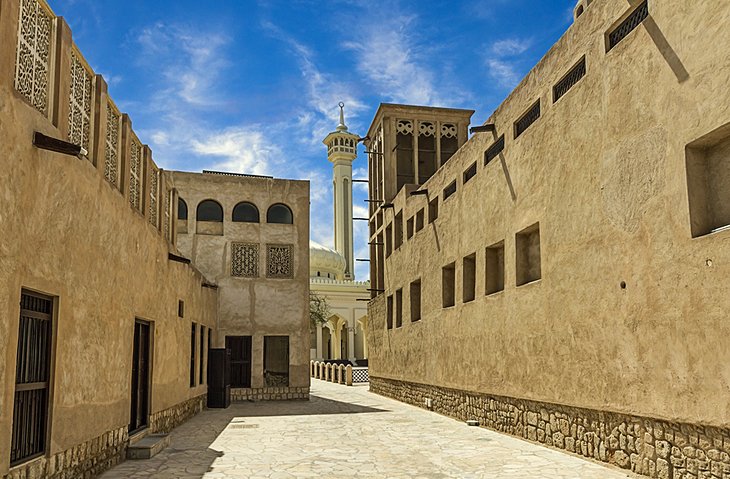
Bastakia (Old Dubai)
The Bastakia Quarter (also known as the Al-Fahidi neighborhood) was built in the late 19th century to be the home of wealthy Persian merchants who dealt mainly in pearls and textiles and were lured to Dubai because of the tax-free trading and access to Dubai Creek.
Bastakia occupies the eastern portion of Bur Dubai along the creek, and the coral and limestone buildings here, many with walls topped with wind-towers, have been excellently preserved. Wind-towers provided the homes here with an early form of air conditioning — the wind trapped in the towers was funneled down into the houses. Persian merchants likely transplanted this architectural element (common in Iranian coastal houses) from their home country to the Gulf.
Lined with distinct Arabian architecture, the narrow lanes are highly evocative of a bygone, and much slower, age in Dubai's history. Inside the district, you'll find the Majlis Gallery, with its collection of traditional Arab ceramics and furniture (housed in a wind-tower) and the Al Serkal Cultural Foundation, with a shop, cafe, and rotating art exhibitions (located in one of the historic buildings).
5. Sheikh Saeed Al-Maktoum House
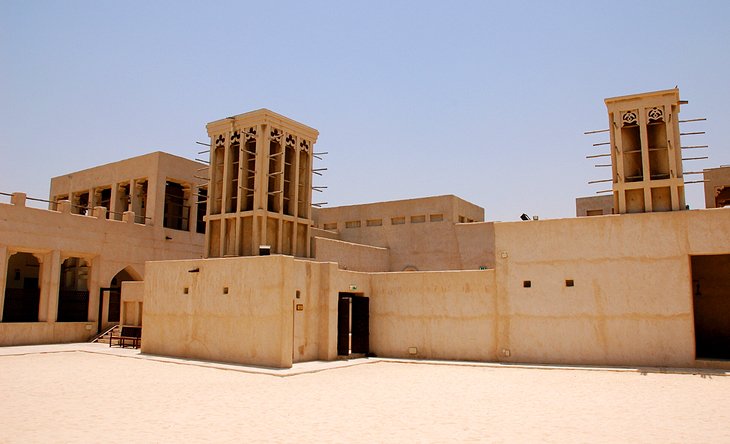
Sheikh Saeed Al-Maktoum House
Sheikh Saeed Al Maktoum was the Ruler of Dubai from 1921 to 1958 and grandfather to the current ruler. His former residence has been rebuilt and restored as a museum that is a fine example of Arabian architecture.
The original house was built in 1896 by Sheikh Saeed's father, so he could observe shipping activity from the balconies. It was demolished, but the current house was rebuilt next to the original site, staying true to the original model by incorporating carved teak doors, wooden lattice screens across the windows, and gypsum ventilation screens with floral and geometric designs. Thirty rooms are built around a central courtyard with wind-tower details on top.
Inside are the exhibits of the Dubai Museum of Historical Photographs and Documents, with many wonderful old photographs of Dubai from the period between 1948 and 1953. The marine wing of the museum has photos of fishing, pearling, and boat building. Throughout the building there are many letters, maps, coins, and stamps on display showing the development of the Emirate.
Nearby is the Sheikh Obaid bin Thani House, restored with displays of traditional interiors.
Address: Al Khaleej Road, Bur Dubai
6. Dubai Creek & Al Seef District
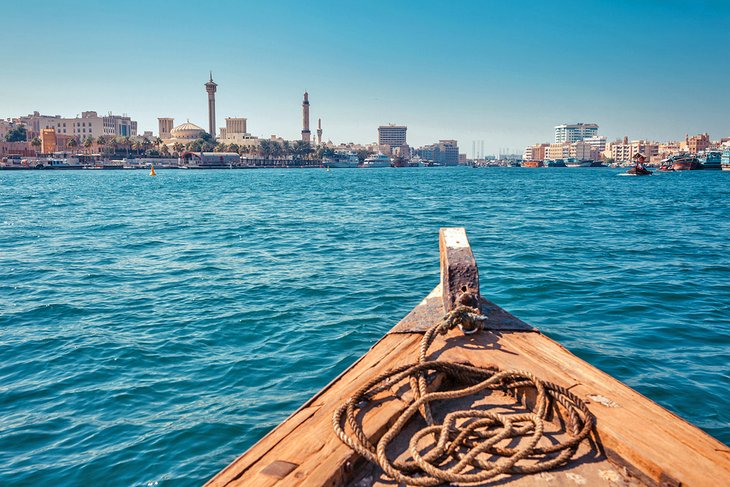
Dubai Creek
Dubai Creek separates the city into two towns, with Deira to the north and Bur Dubai to the south. The creek has been an influential element in the city's growth, first attracting settlers here to fish and pearl dive. Small villages grew up alongside the creek as far back as 4,000 years ago, while the modern era began in the 1830s when the Bani Yas tribe settled in the area.
The Dhow Wharfage is located along Dubai Creek's bank, north of Al-Maktoum Bridge. Still used by small traders from across the Gulf, some of the dhows anchored here are well over 100 years old. You can visit here, watching cargo being loaded and unloaded on and off the dhows. Dhow workers often invite visitors onto the vessels for a tour, where you can gain insight into the life of these traditional sailors. Many of the dhows here travel onward to Kuwait, Iran, Oman, India, and down to Africa's horn. This tiny remnant of Dubai's traditional economy is still a bustling and fascinating place to wander around.
On the Bur Dubai side of the creek, rubbing up against the Bastakia neighborhood, the waterfront has been regenerated as the Al Seef district, with a waterfront promenade backed by traditional coral-block and limestone buildings, a floating market, and shops selling crafts. It's a great place for a stroll with excellent water views.
To travel across the creek, you can either take a trip on one of the many dhows that have been restored as tourist cruise boats or take an abra (small wooden ferry) between the ferry points on the creek's Bur Dubai and Deira banks.
7. Deira
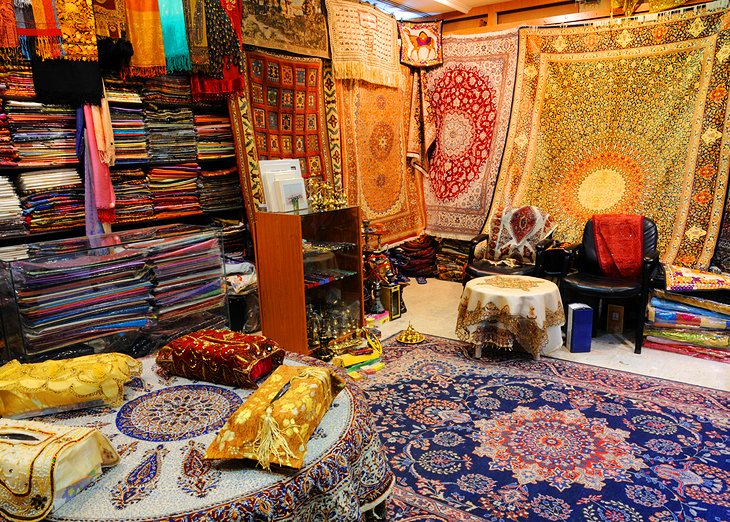
Deira
Deira lies on the northern bank of Dubai Creek, and the winding streets here unveil the melting pot of different nationalities that have come to call Dubai home. On the shore, ancient dhows load and unload with modern banks, hotels, and office buildings as a backdrop.

For travelers, Deira is most famous for its traditional souks (markets), which bustle with shoppers at all times of the day. Deira Gold Souk is world-renowned as the largest gold bazaar in the world. The Deira Spice Souk sells every imaginable spice, with stalls overflowing with bags of frankincense, cumin, paprika, saffron, sumac, and thyme, as well as the fragrant oud wood, rose water, and incense. The fish market provides a much less touristy experience.
While in the district, culture lovers shouldn't miss two of Deira's finely restored architectural gems. Heritage House was built in 1890 as the home of a wealthy Iranian merchant and later became the home of Sheik Ahmed bin Dalmouk (a famous pearl merchant in Dubai). Today, it's a great chance to see the interior of a traditional family home. The Al-Ahmadiya School, constructed in 1912, is the oldest school in Dubai and is now a museum of public education.
Location: Dubai Creek
8. Dubai Frame
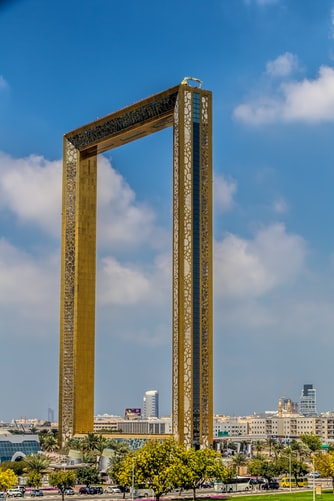
Dubai Frame
Sitting slap-bang between Dubai's older neighborhoods clustered around the creek and the city's modern sprawl, this ginormous 150-meter-high picture frame is one of Dubai's latest sights. Inside, a series of galleries whisk you through the city's history and explore Emirati heritage before you travel up to the Sky Deck, where there are fantastic panoramas of both old and new Dubai to be snapped on the viewing platforms.
Afterwards check out Future Dubai gallery, which imagines what a futuristic vision of the city will look like.
Address: Zabeel Park, Sheikh Khalifa bin Zayed Road
9. Aquaventure Waterpark
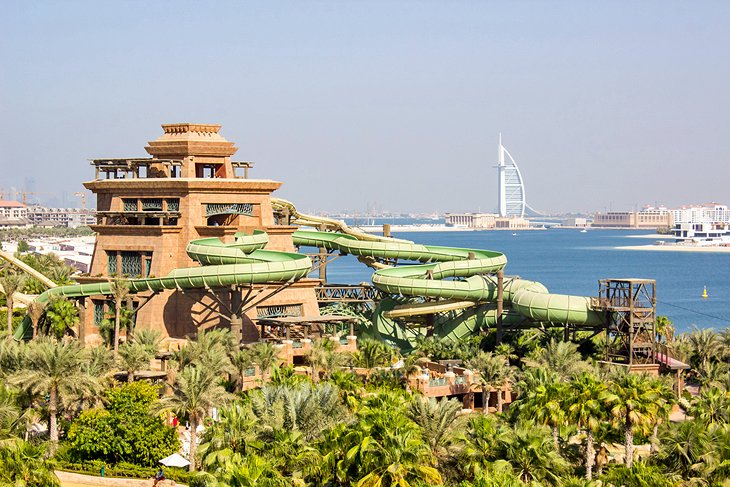
Aquaventure Waterpark
This waterpark, based at Atlantis, The Palm on the Palm Jumeirah — Dubai's famous man-made island development — is a great place to cool off after a few days of hectic shopping and sightseeing. The waterslide action here is excellent and world-class, with the Aquaconda, the world's longest water slide; a nine-story-tall slide, aptly named the Leap of Faith; and water coaster rides. There's also underwater safaris using Sea TREK helmets; a dedicated water play area for smaller children with slides; and for when all your energy has been used up, a 700-meter sweep of white-sand beach.
Address: Crescent Road, Palm Jumeirah, Dubai
10. Dubai Miracle Garden
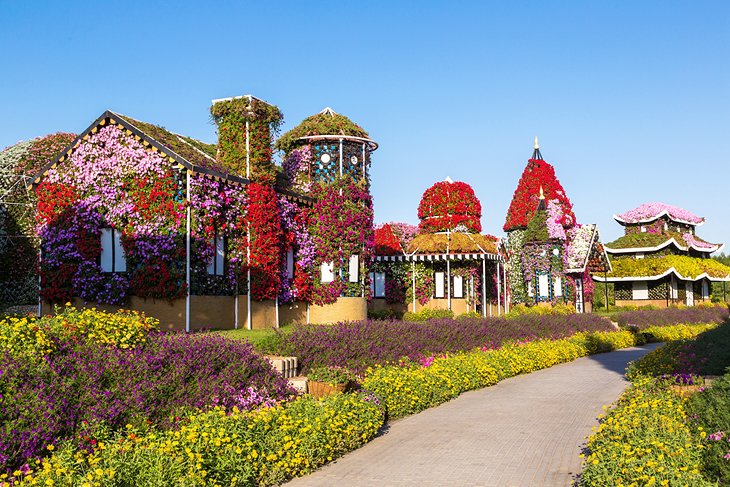
Beautiful flowers blooming at the Dubai Miracle Garden
This is the zaniest garden ever. Not content with constructing the world's largest buildings and malls, Dubai has created the world's largest flower garden, spanning 2,000 square meters and home to a reputed 100 million flowers. Everything that can be covered with flowers has been, from twee English-style cottages to windmills and trucks. There's even a flower version of the Burj Khalifa. Stroll the walkways and enjoy the riot of color and the wacky flower displays.
Address: Sheikh Mohammed bin Zayed Rd, Al Barsha
11. The Dubai Marina and Jumeirah Beach Residence Walk
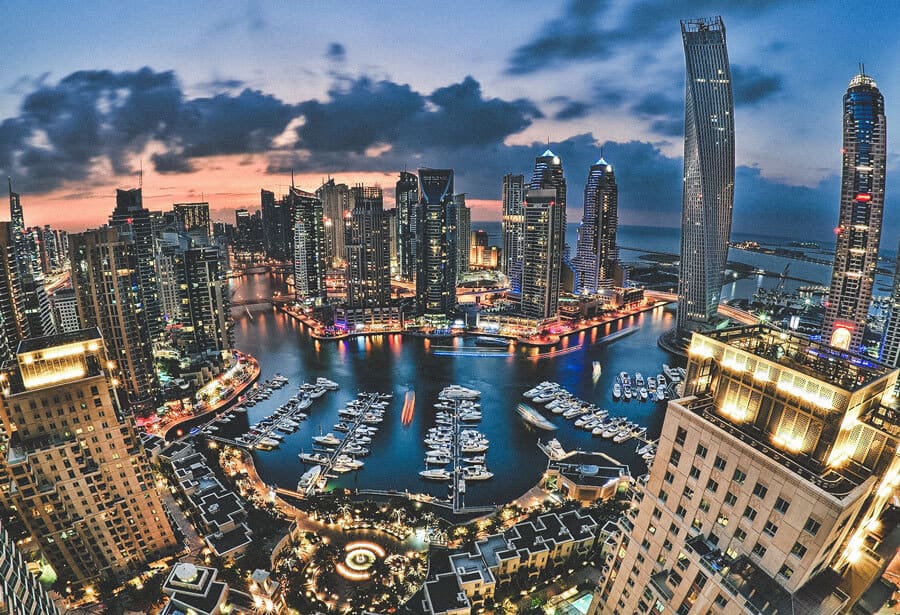
Things to do in the Dubai Marina :
This is the most pristine community I have ever seen in my life. Every single brick of every single building is meticulously placed and beautifully maintained.
If you are looking for things to do in the Dubai Mariana, this neighborhood features tons of high rise condominiums, cafes, bars, more shopping malls, beautiful hotels, beach access, and a waterway snaking through the center. I took a water taxi down the waterway and couldn’t stop gawking at the endless amount of perfect buildings.
12. The Dubai Fountains
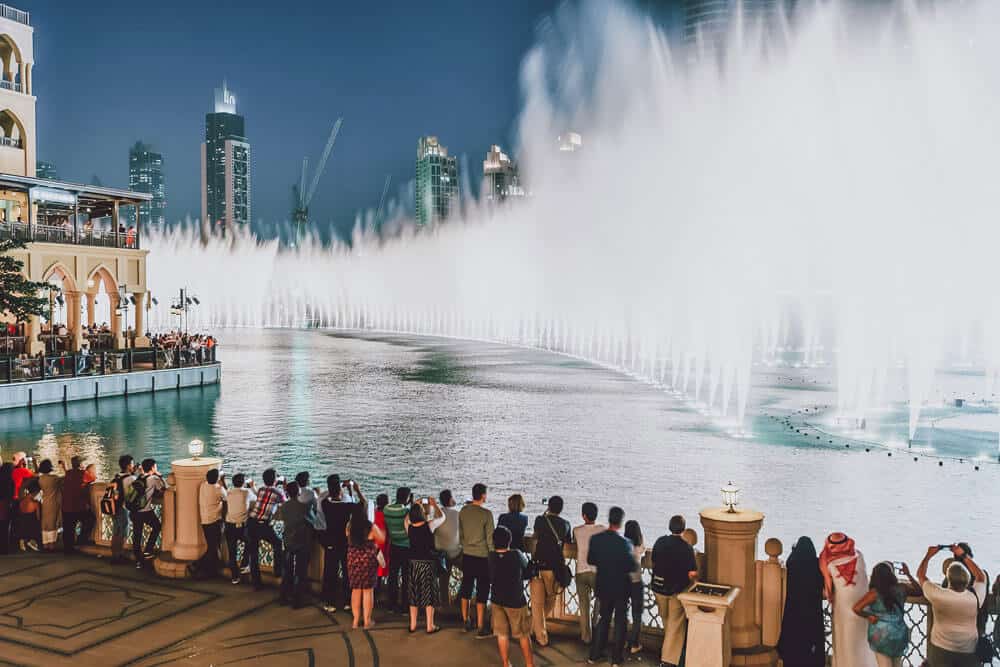
If you have been to the Bellagio fountains in Las Vegas, then you get the idea of what the Dubai fountains are, now just make that idea a lot bigger and more grand.
These fountains are also located at The Dubai Mall, and nightly shows feature the fountains spraying and dancing to a vast array of music.
The best part about this show is that it is free.

